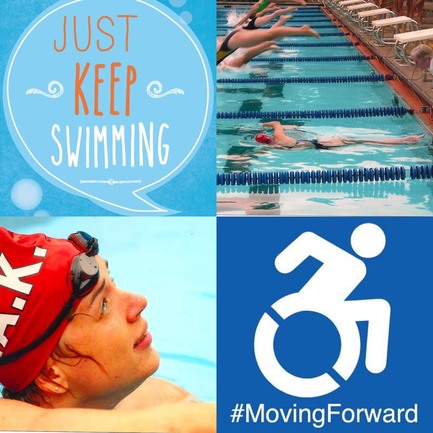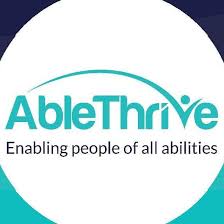|
(This blog tells my family's story. To see more, click "blog" at the top of this webpage.)
Beth felt ready to race with her high school team at the Sectional Championships. She swam the 50 freestyle in a fast 1:13.40, a short-course American Record in her S3 classification. Or, it would have been, except the officials messed up and the meet was not sanctioned, despite Coach Peggy’s advance request. The fastest swimmers at Sectionals advanced to the District Championships the following weekend. Someone with a physical disability like Beth had no chance of qualifying for the District meet. She planned to go to cheer on her teammates, but Peggy told her to bring her swimsuit and goggles. Since the District meet definitely would be sanctioned, the rest of Beth’s high school team unanimously voted to give her one of their relay slots so she could set her first two short-course American Records. The girls on the relay team gave up their chance to win because of the substitution. In the locker room, I helped Beth into her swimsuit while she stressed about their sacrifice. She also thought her high school season had ended the week before. It didn’t help when the meet announcer told everyone in the packed natatorium about her potential records before her relay started. Beth entered the pool from the side and swam to her lane. Meanwhile, Peggy moved into position, stomach down on the deck with her head over the water. Peggy reached low to grab Beth’s feet and hold them to the starting wall, a legal start for a swimmer with limited hand function. Repeated trials had determined the intricate details of Beth’s optimum position to start each stroke. An arm straight or bent, trunk angled or supine, and the mechanics of floating motionless until the starting buzzer. In the first leg of the 400 relay, Beth achieved her first two official short-course Paralympic S3 American Records, drawing enthusiastic applause from the large crowd. However, with the added stress, her time in the 50 free clocked in nine seconds slower than the week before, and the 100 free at seventeen seconds slower. Beth never asked for recognition, but hearing her new American Records announced at school on Monday morning was a nice surprise. Next: A Sudden Emergency!
4 Comments
(This blog tells my family's story. To see more, click "blog" at the top of this webpage.)
The annual New Year’s Eve bash with Ellen and Lizzy involved more fondue and more treats. How easily the seventeen-year-olds laughed while watching the Grinch movie. Listening to them, there was no way of knowing that one of them had a severe physical disability. John and I toasted the New Year with gratitude and discussed how Beth’s injury had never been a tragedy—for her. We believed she had a better than average chance to contribute and be happy. My disability-related worries looped through the days. They could be condensed down to health risks and one big question: What kind of welcome would a young quad receive from a superficial world? I bought Beth a Harvard sweatshirt online for a Christmas gift. When she wore it to school in January, her classmates and teachers found out about her college choice, if they asked. Beth asked to attend Harvard’s admitted students weekend, even though she had already accepted. I agreed and scheduled meetings at the Harvard disability services office to figure out exactly how it would work. I had already booked flights to Minneapolis for the US Paralympic Trials in April, so I changed our flights home from Trials to take us directly to Boston for the Harvard weekend. Beth’s senior spring filled up our calendar with exciting trips and important events. As the end of the high school swim season approached, Peggy adjusted the specifics of training over weeks to promote fast times at the final meets. (‘Tapering’ workouts.) The girls stopped shaving their legs. Some practices added ankle weights. One evening at the YMCA, Beth wore street clothes and shoes in the water along with the rest of the team. Then, the night before the Sectional Championship Meet, the girls shaved their legs. The boys on the team chose to shave their heads in solidarity. All of this was new to us, as well as the excitement to follow. Next: District Championships! (This blog tells my family's story. To see more, click "blog" at the top of this webpage.)
John drove Beth to and from high school swim practices on the evenings I worked at the group home. Ohio's winter weather froze the streets--and wheelchair wheels. Beth insisted on wearing her favorite red flip-flops to practice. They stayed in place with an elastic strap I sewed on. She plowed her manual chair through light snow. Responding to questions about her footwear, she replied with a smile that she couldn’t feel her feet. If pressed, Beth also mentioned the very short distance from the YMCA entrance to the car and from the car garage to the house. Going anywhere else in icy conditions, she wore shoes or boots. With no socks. Despite several different kinds I bought for her to try. Beth survived her healthy teenage stubborn streak, without frostbite, by limiting her time outdoors in the winter. December blurred with my added responsibilities at the group home. We passed the state inspection with flying colors, only because I put in volunteer hours. The four men planned with me to host a Christmas party for their family and friends. It was a big deal for them, a first for the group home. Beth visited ahead of time to help us make cookies for the event. It made me happy to see how much the residents loved the well-attended party. I bought college choir CDs from Ben's and Maria’s holiday concerts and played them continuously in the car. At the Christmas party in Toledo for the spinal cord injury group, a mom thanked Beth for encouraging her young son to start swimming lessons. His scoliosis stopped progressing, avoiding major surgery. The doctor credited swimming for his stronger back muscles. At the first home meet of the season for the high school team, Beth swam the 100 butterfly in under four minutes. Her time qualified for a US Paralympics S3 American Record. However, it didn’t count because the meet had not been sanctioned ahead of time with USA Swimming. “Beth just keeps improving with every meet,” Peggy said. ”It's awesome to watch her strokes and racing ability move forward.” A picture in the Tiffin newspaper showed teammates at the end of the lane cheering Beth on as she turned at the wall. Lizzy and Ellen shouted from the bleachers. “It's fun climbing out of the pool and hearing people clapping for you,” Beth said. “It gives you a little boost of confidence.” (This blog tells my family's story. To see more, click "blog" at the top of this webpage.)
In early December, a long-awaited email changed our course. Beth’s unexpected acceptance to Harvard College launched another shift in the horizon for my family. After reading the email, she lowered herself to the living room floor in her lift chair. Lying on her back, she spread out her arms, closed her eyes, and smiled. Incredulous, I watched my jubilant daughter. What would happen next? She had planned to send out more college applications. A few days later, Beth told me she didn’t want to apply anywhere else. She said that if she didn’t attend Harvard, she would always wonder what might have been. John and I decided to make it happen. Tuition would be $27,448 for the 2004-2005 school year. Add room and board plus fees for a total of $39,880. Plus travel costs and my living expenses off-campus. John and I intended to borrow money on our home, though four years of Harvard would cost more than it was worth. Beth applied for more college scholarships. She chose not to broadcast the acceptance beyond her family and best friends. For the first swim meet of the high school season, the girls on the Tiffin team painted their nails in school colors, blue and gold. I drove with Beth to the away meet since an accessible bus wasn’t available for the swim team. A flight of steps led down to the pool and parents watched from a higher level. Beth shared the safest way to move her manual wheelchair on stairs with two teammates. We learned that high school competitions ran like USA Swimming meets, but on a much smaller and less formal scale. Everyone seemed to stare at the girl in the wheelchair, but Beth didn’t let it bother her. In the 100-yard butterfly, she finished third—one of three swimmers in the race. “I was able to score quite a few points in high school. My coach put me in the harder events that nobody wanted to do, like the butterfly. Since the top three swimmers scored, as long as I finished I would score points.” After the meet, Beth hurried and left the locker room just after the rest of the team. She found herself alone by the pool, so I bumped her up the steps. Peggy and the team apologized a few minutes later in the lobby, but I completely understood. My youngest made it easy to forget she used a wheelchair. (This blog tells my family's story. To see more, click "blog" at the top of this webpage.)
I had stayed through my daughter Beth’s first high school swim team practice, in case she needed my help. She didn't. So for all the others, John or I dropped her off at the entrance of the YMCA, left, and returned later in the evening to wait for her after practice. Changing in her wheelchair on her own was time-consuming at first, even loose sweatpants over a wet swimsuit. She usually wheeled out the YMCA door into a nearly empty parking lot. Officials with the U.S. Anti-Doping Agency interrupted a high school practice for one of Beth’s random drug tests, her first outside of a national meet. Her teammates were impressed. We sent in another quarterly report for USADA with her location at all times, as she would for the next five years as a member of the U.S. Paralympics Swimming National Team. Letters arrived periodically to verify she passed the tests. I submitted the extra paperwork and doctor signatures to allow for her one prescription, advair, to keep her asthma symptoms in check. Routine tests in Toledo showed small, but steady gains in lung capacity. “It pushes her to train with us, and it pushes the other kids because it’s taught them that all things are possible,” Coach Peggy said. Peggy met Beth for an additional practice at the YMCA most weeks, so we rarely made it to the Toledo pool. I arranged my work hours at the group home to be available for swim meets. The once-a-year USA Swimming Disability Championships evolved into Can-Am Paralympic meets twice a year, one in the U.S. and one in Canada. The United States also hosted a special Trials meet every four years before the Paralympics. At a Can-Am meet in Indianapolis in November, my daughter earned two American Records in the 100 and 200 freestyle. “Three years ago, the only way I could swim was with two physical therapists holding me in the water,” Beth said. “Since then, swimming has become a significant part of my life.” I made travel plans for the April Trials meet five months ahead, though we didn't know if Beth would qualify for the 2004 Paralympics. Or if September in Athens would be an option with whatever college she would attend. What we did know: women in the S3 classification would be cut to only three events in Greece, the 50 and 100 free, and the 50 back. The reason? The small number of S3 swimmers in the world. It made no sense to me to restrict exceptional athletes who dealt with enough limits from severe disabilities. Beth moved up the International Paralympic Committee World Rankings to tenth or better in several events, including the individual medley. Many S3 swimmers struggled with long races. She pushed herself farther at every swim practice. The greater the race distance, the higher her world ranking. However, the 100 free would be the longest event for S3 swimmers at the ultimate competition held every four years—the Paralympics. “My favorite event is the freestyle,” Beth said, “but fewer people who have (severe) disabilities can do the butterfly and breaststroke, so I’m grateful I can.” The strokes she was grateful for also would not be an option at the Paralympics for S3 swimmers. The unfair cuts frustrated me, while Beth resigned herself to more restrictions and carried on. Next: a monumental change of direction!  (This blog tells my family's story. To see more, click "blog" at the top of this webpage.) Beth’s wheelchair didn’t rule out anything she really wanted to do. At 17, she started a dozen college scholarship applications and competed on the quiz bowl team. She continually volunteered with different groups, including the Tiffin student athletes who visited elementary schools. A Paralympic coach asked Beth to mentor a teenager from Seattle with a new spinal cord injury. The girls exchanged emails about wheelchairs and prom dresses. At the first practice of the season for the high school swim team, I sat on the YMCA bleachers with a book in case Beth needed me. I usually put on her swim cap—after she tried to do it by herself first—and lowered her from the wheelchair to the deck. Coach Peggy competently took over the tasks. Each swimmer carried a net bag with workout gear. In Beth’s, the typical flat paddles had been cut to a smaller size to fit her hands, with the flexible tubes adjusted to hold the paddles in place. Floating aids strapped on with Velcro. She also utilized a tempo trainer, a battery-operated device the size of a watch face. It worked like a metronome from music class, clicking out the ideal pace. I couldn’t imagine a better coach than Peggy. She modified the team’s workout with creative variations to avoid too much stress on specific arm and shoulder muscles. She also supervised circle turns. Beth couldn’t flip at the wall and push off with her feet like her teammates could. To finish a lap, she approached the wall at the left side of the lane, pushed off with one hand, and completed the half circle to start another lap. “Walls are bad for me,” Beth said. The fewer walls in a race, the faster her times. High school competitions took place in short-course, 25-yard pools. A 100-yard race required three circle turns at the walls. At the end of the first high school team practice, Beth swam to a corner of the pool. With her back to the corner, she placed her hands on the low deck to lift herself out of the water to a sitting position. She tried a few times, almost making it, before being lifted out. She always needed help to get from the deck to her wheelchair and didn’t mind when the boys on the team volunteered. I caught up with her on the way to the locker room, expecting to assist. Beth decided to go it alone for the first time and declined politely. She joined the rest of the girls in the locker room. I waited impatiently in the lobby, wondering if she changed her mind. Sitting in her wheelchair, Beth lifted a knee with her wrist to raise a foot. The opposite hand guided one side of her sweatpants over the dangling foot, before shifting to do the same for the other side. With the goal of placing her feet back on the chair rest with the pants bunched up around both ankles. Eventually, she used her fists and the one finger she could control to slowly pull the sweats up and over her knees. When the pants reached her thighs, she rocked from side to side to continue the prolonged fight. Next, she scooted forward and leaned her shoulders on the back of the chair. Anchored, she lifted her bottom up a few inches to pull the sweats all the way up—inch by inch. In the meantime, the rest of her team showered, changed, and left the YMCA, I found her in the locker room with the sweatpants mostly on. Beth’s first after-swimming solution for independence? Put on baggy sweatpants over a wet suit and then leave to shower at home. Easier said than done. Next: Travel Plans! |
Cindy KolbeSign up for my Just Keep Swimming Newsletter by typing your email address in the box. Thanks!Categories
All
Archives
November 2022
|






 RSS Feed
RSS Feed











